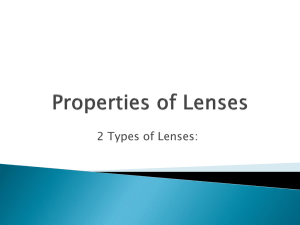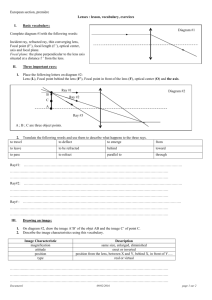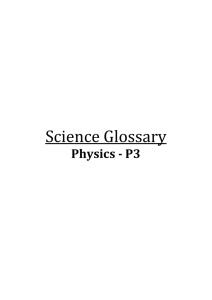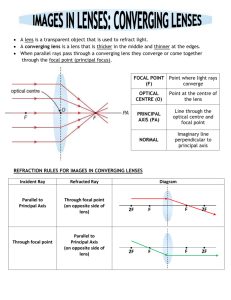Light Rays
advertisement
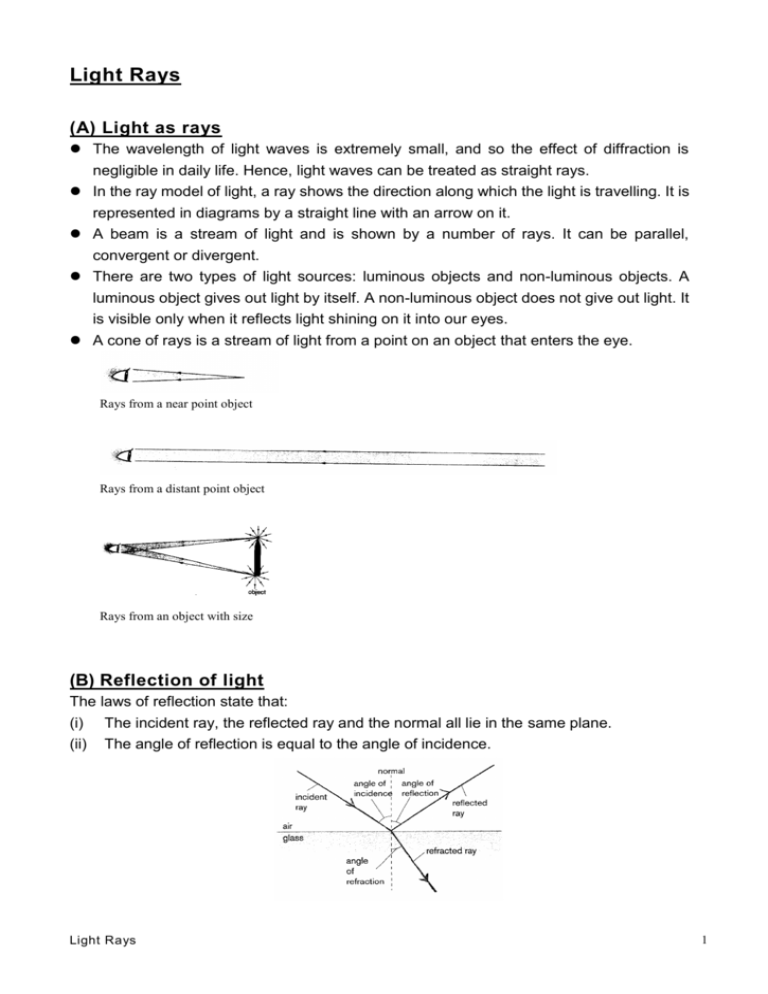
Light Rays (A) Light as rays The wavelength of light waves is extremely small, and so the effect of diffraction is negligible in daily life. Hence, light waves can be treated as straight rays. In the ray model of light, a ray shows the direction along which the light is travelling. It is represented in diagrams by a straight line with an arrow on it. A beam is a stream of light and is shown by a number of rays. It can be parallel, convergent or divergent. There are two types of light sources: luminous objects and non-luminous objects. A luminous object gives out light by itself. A non-luminous object does not give out light. It is visible only when it reflects light shining on it into our eyes. A cone of rays is a stream of light from a point on an object that enters the eye. Rays from a near point object Rays from a distant point object Rays from an object with size (B) Reflection of light The laws of reflection state that: (i) The incident ray, the reflected ray and the normal all lie in the same plane. (ii) The angle of reflection is equal to the angle of incidence. Light Rays 1 Regular reflection is reflection from a flat, smooth surface such that light is reflected in one direction only. Diffuse reflection is reflection from a rough surface such that light is reflected in many different directions. It enables us to see objects which are rough from all directions. An image can be formed by a plane mirror. Properties of the image are: (i) virtual, (ii) as far behind the mirror as the object is in front, (iii) of the same size as the object, (iv) the right way up but laterally inverted. (C) Refraction of light Refraction is the bending of light as it passes from one medium to another. Refraction is due to light travelling at different speeds in the two media. The laws of refraction state that: (i) The incident ray, the refracted ray and the normal all lie in the same plane. (ii) The ratio of the sine of the angle of incidence to the sine of the angle of refraction is a constant (Snell's law). A useful form of Snell's law is n1 sin 1 n2 sin 2 , where n1, n2 are the refractive indices of the media. Light Rays 2 Refraction causes swimming pools and underwater objects to look shallower than they really are. (D) Total internal reflection Total internal reflection occurs when light travels from an optically denser medium to an optically less dense medium at an angle greater than the critical angle C of the denser medium. If the light ray is emergent into vacuum from a medium with refractive index n, the critical angle of the medium can be given by the equation C sin 1 1 or n sin C = 1 n Examples of total internal reflection: Prisms are used instead of mirrors in optical instruments because they produce images of better quality. (Reflection by a plane mirror causes multiple images.) Use of prisms in a periscope Light Rays Multiple images formed by a plane mirror 3 A road appears wet on a hot day because of total internal reflection. This type of illusion is called mirage. Light from the sky is gradually refracted more towards the horizontal as the air near the ground has a lower refractive index (optically less dense). Total internal reflection takes place when it meets a layer of air at an angle greater than the critical angle. The image of the sky is then formed on the road and the road appears wet. An optical fibre guides light along its twists and turns by a series of total internal reflections. A diamond sparkles because of total internal reflection. A fish or a diver under water can see everything above the water surface with their view squeezed into a cone. Outside this cone, the surface looks like a mirror. Light Rays 4 (E) Lenses (1) Key Features of Lenses The optical centre is the centre of a lens. Light rays passing through it do not change direction. The principal axis is the line passing through the optical centre and perpendicular to the lens. Rays parallel to the principal axis converge to or diverge from the focus or focal point of a lens. The principal focus is the point that rays parallel to the principal axis converge to (for convex lens) or appear to diverge from (for concave lens) after they pass the lens. Each lens has two principal foci, one on each side of it. The focal length is the distance of the focus from the optical centre. A thicker convex lens converges light more and thus has a shorter focal length. A thicker concave lens diverges light more and thus has a shorter focal length. The focal plane is the plane containing the principal focus and perpendicular to the principal axis of the lens. (2) Converging Lenses and Diverging Lenses A convex lens is a converging lens: rays converge or bend inwards on passing through it. A concave lens is a diverging lens: rays diverge or bends outwards on passing through it. Rays parallel to the principal axis converge to or diverge from the focus or focal point of a lens. (3) Real Image and Virtual Image A real image can be captured on a screen; rays actually meet at the image. Light Rays 5 A virtual image cannot be captured on a screen; rays appear to come from the image. (4) Graphical Construction of image formation Construction rules Convex lenses (converging) Concave lenses (diverging) A ray parallel to the principal axis is refracted through the principal focus. A ray parallel to the principal axis is refracted so that it appears to come from the principal focus. A ray passing through the principal focus is refracted parallel to the principal axis. A ray directed towards the principal focus a the other side of the lens is refracted parallel to the principal axis. A ray passing through optical centre travels straight on. A ray passing through optical centre travels straight on. (5) Magnification image height ( size ) image dis tan ce Magnification = = object height ( size ) object dis tan ce (6) Image nature and position (i) Convex lens Image plane Real, on focal inverted, diminished. Image between and 2F F Real, inverted, diminished. Light Rays 6 Image at 2F Real, inverted, same size. Image beyond 2F Real, inverted, magnified. Refracted rays are parallel - image formed at infinity. Image on the same side of the object Virtual, erect, magnified. (ii) Concave lens Image on focal plane on the same side of the object Virtual, erect, diminished. Image on the same side of the object Virtual, erect, diminished. Light Rays 7
